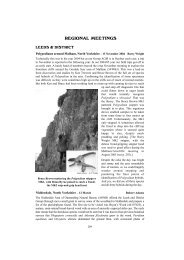Full Contents as pdf File - Natural History Museum
Full Contents as pdf File - Natural History Museum
Full Contents as pdf File - Natural History Museum
You also want an ePaper? Increase the reach of your titles
YUMPU automatically turns print PDFs into web optimized ePapers that Google loves.
We returned to Ross C<strong>as</strong>tle for lunch before setting off for the Old Kenmare Road above<br />
Torc Waterfall in search of the Polystichum lonchitis previously recorded there. From the<br />
car en route, Asplenium ceterach w<strong>as</strong> seen growing on roadside walls. The cars were left at<br />
a large car park at the head of the waterfall (00/967841) and we set off along the Old<br />
Kenmare Road. The rocks on either side of the track were covered in v<strong>as</strong>t quantities of<br />
filmy ferns, mostly Hymenophyllum tunbrigense and the usual woodland ferns were seen.<br />
An addition to our finds for the day w<strong>as</strong> Asplenium adiantum-nigrum. We found a number<br />
of plants of Polystichum aculeatum by dripping rocks exactly <strong>as</strong> described in the old record<br />
and we surmised that the<br />
record for P. lonchitis had<br />
probably been an error and<br />
w<strong>as</strong> in fact immature<br />
P. aculeatum. Under pine<br />
trees nearby w<strong>as</strong> a colony<br />
of lesser twayblade found<br />
by Christine Mullins. We<br />
again searched around<br />
Torc Waterfall for<br />
photo: A.H. Ogden<br />
Killarney fern and located<br />
eleven colonies, some of<br />
which appeared to be on<br />
the incre<strong>as</strong>e. With great<br />
daring most of us made the<br />
crossing of the torrent,<br />
balancing on huge<br />
boulders to see the fern<br />
Karen Munyard, Gill & Bryan Smith & Bridget Laue at Torc<br />
growing on the opposite<br />
side from the path.<br />
Another short drive took us to a tunnel through the rocks by Upper Lake (00/919821),<br />
where Alison had previously found Asplenium onopteris and A. x ticinense. Bryan found<br />
both growing on a rock-face behind brambles.<br />
This completed the day’s ferning and we headed back to our accommodation and met again<br />
later for a splendid meal at The Fishery Restaurant in Killorglin.<br />
Dingle Peninsula (Thursday) Paul Ripley<br />
Shortly after leaving our b<strong>as</strong>e we stopped at Killorglin Bridge. A very nicely crenate<br />
Asplenium ceterach, A. ruta-muraria, A. scolopendrium, A. trichomanes subsp. quadrivalens<br />
and Polypodium vulgare agg. were growing on the walls. We also admired the statue of<br />
King Puck. A three day fair is held at Killorglin every year and at ‘the gathering’ a goat is<br />
brought down from the mountains and crowned King Puck until ‘the dispersal’ on the l<strong>as</strong>t<br />
day.<br />
We stopped for an hour in the attractive town of Dingle, near the b<strong>as</strong>e of the peninsula of<br />
that name. Bookshops in the town were disappointing but we did see Polypodium<br />
cambricum on the walls. The roads towards Ventry were interesting for well grown plants<br />
of Dicksonia antarctica (01/420003) but we also saw Polypodium interjectum, Athyrium<br />
filix-femina, Polystichum setiferum, Dryopteris affinis, D. filix-m<strong>as</strong> and Pteridium<br />
aquilinum, <strong>as</strong> well <strong>as</strong> a crisped form of Asplenium scolopendrium.<br />
Connor P<strong>as</strong>s links the south and north of Dingle peninsula and we stopped near the summit<br />
in excellent weather to have lunch. Isoetes lacustris grows in the clear waters of the lake<br />
(01/504059), but we also found Asplenium ceterach, A. trichomanes, Polypodium vulgare,<br />
94

















